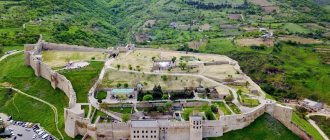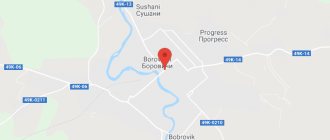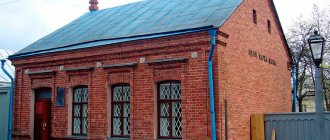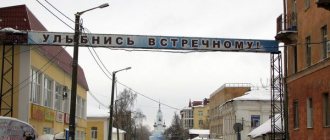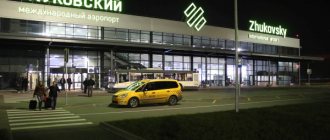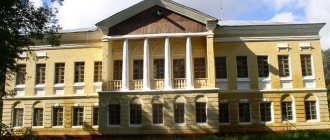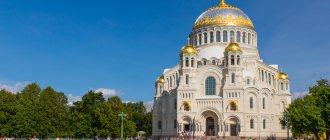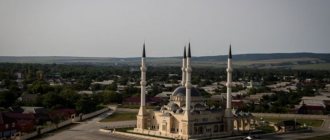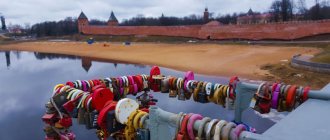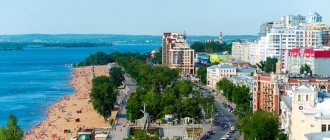Volgograd is a city on the Volga. One of the twelve cities whose military glory and whose military sacrifices are so great that these cities bear the title of hero city. Rebuilt after the Great Patriotic War, Volgograd is imbued with the memory of the Battle of Stalingrad, which unfolded here from July 1942 to February 1943. Tsaritsyn, Stalingrad, and now Volgograd - a city on the Volga. The sights of Volgograd are strictly military in nature when it comes to monuments, and only recently monuments not related to the events of the Battle of Stalingrad began to appear in the city.
We were given one day for a tour of Volgograd. During this day we managed to visit the Mamayev Kurgan memorial complex, see the Battle of Stalingrad panorama museum and walk around the city itself. The excursion to Mamayev Kurgan was of central importance in our hike, so we decided to start there. Plus, the climb to the memorial complex is located from east to west, so by visiting it in the first half of the day you will avoid the blinding sun. Article about Mamayev Kurgan.
Many tourists begin their acquaintance with Volgograd from the 62nd Army Embankment. There is a river station here, where tourists arrive on cruise ships. We arrived in the hero city by rail. Therefore, our acquaintance with the city of military glory began from its railway station. The building itself, like almost everything in Volgograd, was built after the war in 1954.
Excursion around Volgograd
In 2013, a replica of the famous Barmaley fountain was installed on the station square. But unlike the original fountain, the figures of the children have grown significantly longer. During Soviet times, this was a standard fountain installed in many cities. He became famous thanks to a series of photographs taken by photojournalist Emmanuel Noevich Evzerikhin after an air raid on August 23, 1942. The photographs clearly show the contrast between the destroyed and burning city and the carefree child figures on the fountain.
We begin our movement from Station Square to the main transport of Volgograd - the High Speed Tram. It will be convenient for us to navigate between all the attractions that we planned to see. So, from Station Square we go down Gogol Street and find ourselves in a large square. If we go down, we will get to the Square of Fallen Fighters, but we decided to leave this attraction for the end of the walk. To our right is a monument to Alexander Nevsky, and the building with colonnades is the New Experimental Theater. Behind it is the Komsomolsky Garden, in which there is a bust of Nikolai Vasilyevich Gogol. This is the oldest monument in Volgograd. He survived both the repressions of the Soviet regime and the Battle of Stalingrad. It was found in ruins and restored.
We walk two blocks along Mira Street and turn left along Krasnoznamenskaya Street. One more block and now we are on the main street of Volgograd - Lenin Avenue. It is along this route that the famous high-speed trams of Volgograd run. You really won't see them here. Here they walk underground. Pionerskaya station was on our right hand. Forward!
We took a tram to the Profsoyuznaya station, the deepest station of the High Speed Tram, its depth is 14 meters. Here is one of the restaurants of the famous fast food chain, where we had breakfast, drank coffee and were ready to rush into battle.
Save your trip summary too!
- Tickets to Volgograd – ~2000 rubles from the capital.
- Chicken Kiev, eaten on the way – 50 rubles. Take it with cheese and mushrooms!
- Lunch in the kitchen – ~200-250 rubles per person.
- Museum of the Captivity of Marshal Paulus – 50 rubles. adults, 30 rub. – children, students. Cats are not allowed.
- Magnets – ~from 80 rub. per piece
- Time spent walking ~ 4-5 hours (with breaks for food and museum)
But that is not all! Ahead of us is Mamaev Kurgan and the Motherland! You need to see it today in order to go to the “Stalingrad Panorama” tomorrow. I invite you too!
Metrotram in Volgograd - high-speed tram
Because of its unusual nature, the Volgograd high-speed tram has become one of the city's attractions, but in reality there is nothing unusual about it. The high-speed tram in Volgograd was born in 1984. A special feature of the metro-tram is that some of the stations are located underground, in the manner of metro stations, and the Volgograd underground stations were designed in such a way that they can be modernized for use as full-fledged metro stations. But there is no metro in Volgograd yet, but there is a high-speed tram. It carries up to 10 million passengers annually and does it very quickly, because it has no intersections with the roadway or pedestrian areas. In a word - High Speed Tram!
The High Speed Tram line runs along Lenin Avenue, past all the main attractions of the city. First of all, we went to Mamayev Kurgan, the tram stop is called that. We walked there for about three hours. The recommended minimum time for visiting is 1.5-2 hours. Details on our website - article about Mamayev Kurgan. After that, we took the tram again and got to the Lenin Square stop. In the center of the square there is a monument to the leader of the peoples. The colonnade behind the monument unites several residential buildings. The house in the middle with a memorable bas-relief on the end is the legendary house of Pavlov, a senior sergeant of the Soviet troops, who held the defense of this house for 58 days. In memory of superhuman courage and valor, the house was one of the first to be restored after the end of the Battle of Stalingrad.
By the time we got to Lenin Square, it was already well after noon, and the sun was so hot that the water we drank immediately evaporated from the body. It was decided to have lunch and wait out the heat of the day. Near the square there are several cozy and very inexpensive restaurants, in one of which we had lunch. Two salads, kebab, soup and tea. This lunch cost us 900 rubles.
Towards the Volga, across the road from Lenin Square there is a panorama museum of the Battle of Stalingrad. This is one of the main attractions of the hero city; leaving the city without visiting this museum would be simply a crime. The only thing that should stop you from visiting the museum is Monday. On Mondays, the Panorama Museum, like most museums in Russia, is closed. The museum itself begins its history with the Tsaritsyn Defense Museum, opened back in 1937. Since then, it has been renamed and rebuilt more than once, and in 1982 the “Battle of Stalingrad” panorama was opened, and the museum itself was opened three years later in 1985.
Second day
Start your next day's walk by visiting the building of the Cossack Theater of the late 19th century. This is a red brick building with stucco, erected by the merchant Shlykov. Since the beginning of the last century, it housed a women's gymnasium, then other educational institutions; after the war, the restored building was given over to a cinema, and in the 1990s to a theater.
Details: Cossack Theater
Cossack Theater Photo: © Natalia Semchina
From the theater you can walk to the Kazan Cathedral . The church was consecrated in 1899; at the end of the 1930s it was closed and turned into a bakery. The building was damaged during the war, restoration was completed by 1948, and in the 1950s the church became a cathedral. The brick building was built in pseudo-Russian style; inside it is worth seeing the paintings made in the middle of the last century.
Details: Kazan Cathedral
Kazan Cathedral Photo: © Natalia Semchina
Next, take the train or buses to the Old Sarepta Museum-Reserve . This is a former colony of Germans from Gerngut, founded in the 18th century. The complex includes more than 20 buildings, dungeons and a museum of Russian mustard. In the museum you can get acquainted with the history of the Herrnhuters and their life in Sarepta, learn how they contributed to the development of the settlement and its transformation into a significant scientific and economic site.
Details: Museum-Reserve "Old Sarepta"
Museum-Reserve “Old Sarepta” Photo: © Catou
From the museum, go to the industrial achievement of the times of the USSR - the first lock of the Volga-Don Shipping Canal named after Lenin . Ideas about the need to build a canal connecting the Volga and Don were voiced several centuries ago, but work was carried out only by 1952. The entrance to the lock is decorated with a majestic arch 40 m high. On one side of the first lock, a monument to Lenin on the site of the Stalin monument, its height - 57 m. Between the monument and the lock there is a walking embankment of the Krasnoarmeysky district. On the other side of the entrance to the canal, a monument to the rivermen of the Volga Military Flotilla , serving as a lighthouse. Those interested in the details of the creation and operation of the canal can go to the Museum of the History of the Volga-Don Shipping Canal , located nearby.
Returning to the city center, you can again visit the embankment of the 62nd Army, go to the river station and take an hour-long walk along the Volga. From the river you will see the sights you have visited along the embankment in a new way, and will also pass under the Volgograd “dancing” bridge . When it gets dark, walk along the Alley of Heroes illuminated to imitate the starry sky. In the evening, you can attend a concert, performance or other cultural event in the Loft 1890 space. It is located in a historical building from the time of Tsaritsyn, this is the only surviving premises of the Zhiguli beer warehouses of the late 19th century.
Detailed advice on what to see in Volgograd in 2 days
Arch of the first lock of the Volga-Don Shipping Canal Photo: © Natalia Semchina
Panorama Museum "Battle of Stalingrad"
The Battle of Stalingrad Museum consists of eight thematic halls, as well as a triumphal and panoramic hall. If you thoughtfully walk through the halls of the museum and read and peer at all the exhibits, then you should set aside a separate day or at least 3-4 hours to explore the museum. Many exhibits related to the defense of Stalingrad are collected here. Personal belongings of battle participants, photo chronicles, uniforms, weapons and shells.
In darkened halls behind glass stands, orders and medals, identity cards, letters and documents of those distant, but so vivid in the memory of generations, are displayed. Here you become imbued with the tragic events that unfolded in Stalingrad in 1942-1943.
These are the cameras that photojournalists used to record historical chronicles.
The museum also widely displays personal belongings, uniforms and orders of the fascist invaders.
Camera “Welfa” trophy N.I. Shatalova.
In the halls of the museum, military weapons of the Soviet troops and fascist invaders are exhibited. This weapon has survived to this day in a variety of forms - from surviving rifles to guns mangled by shrapnel.
One of the main exhibits demonstrating the battles for Stalingrad is an interactive map of the city of Stalingrad. Through projection the city comes to life. An instant air raid and the city is already on fire. This action is well captured in our video, which is at the end of the article.
The exhibit that influenced the very name of the museum is a panoramic canvas located on the top floor of the museum. A circular panorama of the Battle of Stalingrad entitled “The defeat of Nazi troops at Stalingrad.” The canvas, measuring 16 meters in height and 120 meters in length, was painted in oil by masters of the studio of military artists named after M. B. Grekov. The canvas depicts the final stage of the Battle of Stalingrad - Operation Ring. This canvas is the largest painting in Russia.
The museum complex is not limited to museum exhibitions. Outside the complex is the Gerhardt Mill building. These ruins are like a symbol, like a living memory of the days when fierce battles for Stalingrad took place. They decided not to restore the ruins, but also not to demolish them - as a living reminder to descendants.
The history of this mill goes back to 1899. The family of entrepreneur Gerhardt received a contract for the construction of a flour milling complex. The building was quickly built and put into operation, and it remained in operation until the fire of 1907. The mill building burned down completely and a new building was built in its place. It was built using a new technology for Tsaritsyn - a reinforced concrete frame with brick cladding. During Soviet times, the mill was nationalized and became mill No. 4.
A replica of the Crocodile fountain is installed next to the Gerhardt mill. Unlike the replica, which is located on Station Square, this replica exactly repeats the fountain captured in Evzerikhin’s photographs.
Churches and temples
Church of All Saints
Address: st. Mamaev Kurgan, 4 Phone: Website: https://www.volgaprav.ru/hramy_volgograda/centralnyj-rajon/xram-vsex-svyatyx/#.XB4FcusufIV
The Church of All Saints was erected in 2005 on top of the Mamayev Kurgan memorial. The shrine is a monument to fallen soldiers.
On the territory of the memorial complex there is the Vladimir Chapel. The temple contains the first handmade icons, on which the Saints are depicted in three-dimensional form. The images are made of glass, gold and silver threads and beads. A similar manufacturing technology was used 500 years ago.
The shrine is also decorated with an iconostasis painted by the famous icon painter V. Savelyev.
Kazan Cathedral
Address: st. Lipetskaya, 10 Phone: Website: https://volgograd-sobor.ru/ Opening hours: 07:00-19:00 Mon-Sun
The cathedral was built at the end of the 19th century at the expense of parishioners. Temple in pseudo-Russian style.
War and devastation left only the walls from the previous structure. After the victory over the Nazis, reconstruction began. The villagers found out about this and brought to the temple the icon of the Kazan Mother of God and the crucifix, which are still there. The walls of the shrine are also decorated with works by the artist P. Sherdakov.
They say that in the post-war period, people came to the walls of the cathedral to leave a message about a missing loved one and pray for a speedy reunion. Miracles happened and families regained mothers, fathers, spouses and children.
Now on the territory of the Kazan Cathedral you can spend time with your family on the playground, which is located in the courtyard of the temple.
Tsaritsyn Beit David Synagogue
Address: st. Port Said, 11 Phone: Website: eaicy-dar.ru
Beit David Synagogue began operations in 1888 and was the first synagogue school. The building is made in the Moorish style and is one of the surviving buildings from the Tsaritsyn era.
It got its name from the former leader of the Jewish community, David Kolotin.
At the moment, the synagogue building is a physiotherapy clinic, where a six-pointed star visible through the paint serves as an echo from the past.
Temple of John of Kronstadt
Address: st. Tumayana, 38 Phone: Website: https://ik-hram.prihod.ru Opening hours: 07:00-19:00 Mon-Sun
The Church of John of Kronstadt was built in the early 90s and improved to a larger size in 2012. It is named after Father John, who is known for his generosity, kindness and compassion for others, and is nicknamed the People's Elder.
The building is made in the Russian-Byzantine style. Inside there is an icon of St. John - the main and most valuable shrine.
There are also Sunday schools in the temple and a library.
Volgograd embankment
We approached the central embankment of Volgograd from the side of the “Battle of Stalingrad” panorama museum. From the museum it takes 15-20 minutes to walk to the embankment. The embankment is very different from the embankments of other cities of the Volga region in its remoteness from the Volga River itself. A walking park is located on the upper tier of the embankment. This is a very well-kept place, with benches, flower beds and numerous monuments.
Church of John the Baptist, with the monument to Peter and Fevronya of Murom Blessing located next to it. In the background you can see two buildings shaped like sails; this is a Volgograd residential complex.
Monument to the Russian Cossacks or “Cossack Glory”, this is another name for the sculptural composition. The monument became a symbol and reminder of the contribution that the Cossacks made to the defense of Russia.
The monument to the Soviet pilot Viktor Stepanovich Kholzunov was erected in 1940 and restored after the Battle of Stalingrad.
Memorial rotunda at the site of the destruction of an anti-aircraft battery during the Battle of Stalingrad. The central staircase of the Volgograd embankment is visible in the background.
And here is the main attraction of the Central Embankment - the central staircase. It is also called the main gate of the city. The 100 steps culminate in a colonnade of propylaea.
The Art Fountain is located immediately behind the central staircase.
We got here in the evening. The sun was no longer hot, a pleasant breeze blew. The embankment gradually began to fill with people walking.
Alley of Heroes, Volgograd
From here, from the embankment up from the Volga, the Alley of Heroes goes. This is one of the most crowded pedestrian boulevards in Volgograd. People willingly walk along it, and the boulevard itself is also equipped with numerous attractions and monuments to the Battle of Stalingrad.
Chapel of Alexander Nevsky. Until 1932, the main temple of the city of Tsaritsyn was located on this site.
On the left is a monument to Ruben Ibarruri, a Soviet soldier on August 24, 1942, who took command of a machine-gun company that defended a section of the Stalingrad railway for a whole day and stopped the advance of fascist troops, which threatened to cut off Soviet troops from the main group. In this battle, Ruben was wounded and died a week later in the hospital. On the right in the photo is an ordinary poplar at first glance, a natural monument to the Battle of Stalingrad, its trunk is dotted with many fragments. The poplar survived the bombing and withstood the fires.
Where to go to eat
There are also interesting places for lovers of gastronomic tourism. There are several restaurants in the city that will surprise even the most picky eaters.
Gastropub "Library"
A unique place, reminiscent of a traditional English pub in its atmosphere. It is here that guests will be offered to enjoy beer brewed according to an ancient recipe. Live music and a cozy interior dilute the stiffness inherent in the British and help you relax.
In summer, you can choose a table on the open veranda and admire the colorful city. And in winter, warm up by the real fireplace located in the hall. The restaurant often hosts concerts, with local and Russian stars performing.
Guests are offered Russian, European, German cuisine. The menu has vegetarian dishes and children's food, so you can go with your child.
The restaurant is located on the Alley of Heroes, but you can order home delivery.
Cooking “Candy-lambs”
One of the most famous culinary shops in the city of Volgograd, and this is not just one shop, but a whole chain. Customers are offered not only pastries and desserts, but also full meals, including:
- baked fish and meat;
- all kinds of salads;
- dumplings, khinkali, dumplings;
- pancakes with various fillings.
Semi-finished products are always in stock, and it is also possible to place an order. The culinary shop provides delivery, so guests of the city do not need to worry; they will always be provided with a tasty and satisfying dinner.
Cafe "Marusya"
Another place that is popular among Volgograd residents is the Marusya cafe. Its distinctive feature is delicious homemade food with European presentation. Here you can have breakfast with pancakes or cheesecakes, and have a hearty lunch with a large selection of first and second courses.
It is noteworthy that the cafe independently produces cheeses with a unique, delicate taste, so if you are in Volgograd, “Marusya” is a must-visit.
Square of Fallen Fighters, Volgograd
Monument to the Defenders of Red Tsaritsyn and Stalingrad.
Well, we have come to the place where we started today’s excursion. The setting sun was already seeing us off. The time was about nine o'clock in the evening. There was an hour and a half left before the train. The panorama was taken from the zero kilometer of the city of Volgograd. The railway station building is visible in front, and the stele on the Square of Fallen Fighters is behind. If you look at the stele, to the left of it is the building of the Central Department Store, it was rebuilt, but it was in its basements that the headquarters of Field Marshal Paulus was located, where he capitulated. 360 degree panorama on the Central Square.
Volgograd, formerly Stalingrad, and before that Tsaritsyn, the city of military glory. A hero city that defended our freedom at the cost of many thousands of lives. This is a monument city, it is no wonder that the most important monuments of Volgograd remind us of the feat of Stalingrad in the Battle of Stalingrad. Volgograd is a must-visit to learn to feel the connection that eventually breaks and hangs by a thread. This is a connection between generations, a connection between the now deceased, those killed by the war, and us alive, who believe that our life is difficult. And even if our gratitude does not always find a way out, the main thing is that it finds an entrance - an entrance into our hearts. The hero city of Volgograd will definitely find its way to your heart.
Entertainment
Excursions along the Volga
Addresses where you can purchase a ticket for the ship:
- 62nd Army embankment, 6 (River Station building, 1st floor)
- st. Fadeeva, 43 (Krasnoarmeysky district)
- ticket offices on the embankment near the piers
Telephone: , 38-10-81 time of ships from 11.00 to 24.00 every hour from 04/18/2015 to 11/1/2015 Cost: for adults - 300 rubles, for children - 150 rubles.
Excursions on the boat are short - only an hour. During the voyage you will see panoramas of the central districts of the city, monuments at its heights, the Volga sails, the ship will approach the floating monument to sailors and the “dancing” bridge. During the river walk, the guide talks about the history of the city, its monuments, architecture and traditions.
Volgograd Planetarium
Address: st. Gagarina, 14 Phone: Website: https://volgogradplanetarium.ru/ Opening hours: 09:00-18:00 Mon-Sun Cost: adult ticket - 300 rubles, children's ticket - 200 rubles
Already in the fall of 1954, the planetarium opened its doors to receive visitors. The building served as a gift to the entire city, which became a symbol of the desire for progress and peace.
The Volgograd Planetarium is included in the list of the best planetariums in the country and is considered the largest in the Middle and Lower Volga.
Scientific and educational programs, excursions are held here, the history of creation is told, and an astronomical club operates. For example, tourists can visit the Star Hall, where they will get acquainted with the exhibits, see an experiment with a Foucault pendulum, and will also be transported into outer space thanks to the projection on the dome.
The space journey will be accompanied by a story about astronomical objects and phenomena.

